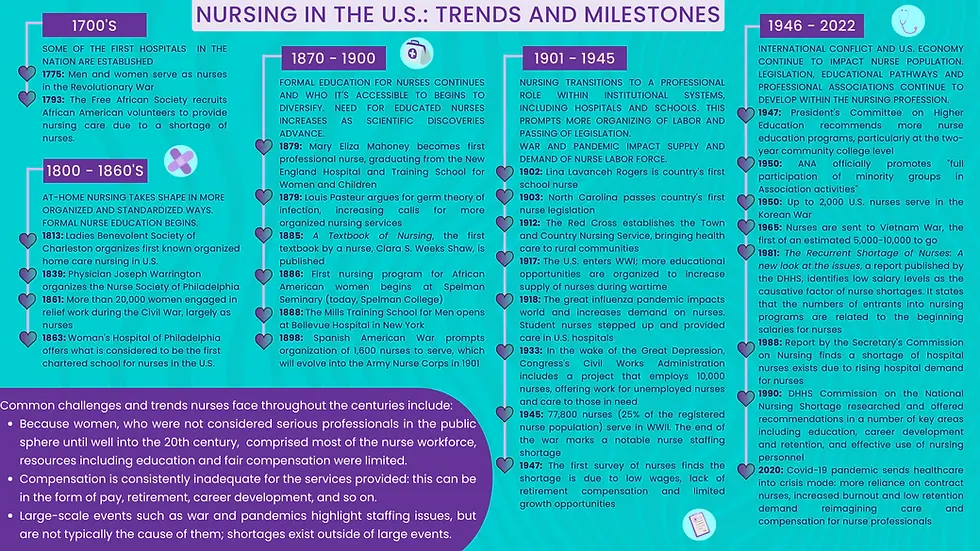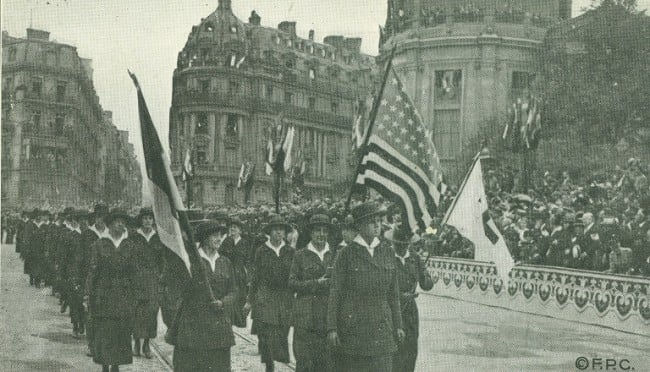Trends in staffing of nurse professionals have shifted from decade to decade; today, in our post-pandemic world, these shifts continue. Data can be analyzed at a granular level to determine which ages, races, education levels, and genders shift within the U.S. nurse population. Sometimes though, it’s helpful to zoom out and take a look at how trends have changed (or stayed the same) over time. Take a look at the timeline below to get a big-picture idea of how major world events and trends in hospital staffing have impacted nurse staffing trends in the U.S.

While this summary merely skims the surface of milestones and trends that have happened over the past centuries, it does highlight a number of common, persistent threads. These include access to education, adequate compensation, sexism in the workplace and the impact societal events such as war, pandemics and economic depression has.
The profession developed first with education, which continues to be a topic of conversation today. Access to educational opportunities is key to building the nurse pipeline. While education of nurses has become more sophisticated over time, it continues to face shortcomings. These include being able to attract and retain qualified, experienced nurses to teach courses, as well as enrolling students who reflect the U.S. population. More students of color and male identifying students are needed in academic settings in order to grow a nurse work force that more closely reflects the country's general population.
Another common thread is that women have been the primary sex to enter the field of nursing, and as such have faced sexism throughout the centuries. Men have been nurses all along too, of course, but women have and continue to make up the majority of the nurse workforce. The role of women in the workforce is a well-documented topic, including within the field of nursing. In short, sexism and its impacts have long held nurses back from fair compensation, enticing growth opportunities, and retirement packages.
War, pandemics, and large economic events such as the Great Depression are catalysts for staffing shortages, but they are not the only causes. At the root of it all is the return nurses receive in exchange for the mental, emotional and physical stresses they offer every day they’re on shift.
Recognizing trends is important because they help us better understand which, when there is a short supply of nurses, approaches might be most effective at filling vacancies. See below for more resources about different strategies, and keep an eye out for an upcoming blog that addresses this topic.
There are many more important and interesting moments in history that have shaped the nursing profession. The University of Pennsylvania has an extensive timeline of events that is well worth checking out! For example, did you know Benjamin Franklin founded one of the nation’s first public hospitals? Check out “Nursing Through Time” to learn more!

You may also want to dig into some of the research that was helpful for shaping this concise blog post:
Nurse staffing shortages are not unique to the U.S.; here’s an article from Canada chronicling many of the same issues U.S. nurses have faced over time: Black, K., 15 October 2021, tvo Today, “So-called women’s work: Sexism in nursing goes way, way back”
An in-depth look at the impacts wage levels have on levels of RNs: Brewer, C.S. (1996), The roller coaster supply of registered nurses: Lessons from the eighties. Res. Nurs. Health, 19: 345-357. https://doi.org/10.1002/(SICI)1098-240X(199608)19:4<345::AID-NUR8>3.0.CO;2-I
For more granular data from 2001 to 2015: Buerhaus, P. I., Skinner, L. E., Auerbach, D. I., & Staiger, D. O. (2017). State of the registered nurse workforce as a new era of health reform emerges. Nursing Economics, 35(5), 229-237.
Kaskela, N., 3 Oct 2021, The Dallas Morning News, “North Texas nurse shortages are nothing new. See how wartime Dallas handled it”
For more granular data re: staffing trends by unit (2018): Paulsen, R. A. (2018). Taking nurse staffing research to the unit level. Nursing management, 49(7), 42.
Timeline of nurse staffing history: UPenn, “Nursing Through Time”
For a historical perspective on the nursing shortage and both external and internal barriers:West, Edith & Griffith, W & Iphofen, Ron. (2007). A historical perspective on the nursing shortage. Medsurg nursing : official journal of the Academy of Medical-Surgical Nurses. 16. 124-30.
History of nursing: Whelan, J. C., “American Nursing: An Introduction to the Past”
April 2001: 1 in 5 nurses surveyed said they're leaving in next 5 years, "New survey says nursing shortage will get worse"
May 2021, The University of St. Augustine for Health Sciences, “The 2021 American Nursing Shortage: A Data Study”

Comments